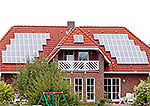Thank you. I do have more questions based on what you said.
DIY install will qualify? I saw that it need to submit a contract with professional installer?
I think so. I'm wondering the same things, probably just not all links/documents complete and correct. I just had service started in my name last weekend (for a new property) and need to get in a reservation.
I previously put in a request for service upgrade (asking if I can have that 3-phase I see on a pole 200' away!)
I don't get this. Do you mean after 20 years I should add a new battery solar system? is it because NEW 3 credit is much less?
Exactly. Your NEM 2.0 installation should be grandfathered for 20 years (or whatever period they later decide to shorten it to.)
I was due to get my NEM 1.0 bumped to 2.0 in a couple years, now expect it will be 3.0 instead.
Under 3.0 the credits will be much less, like PG&E's avoided cost of buying a kWh from a power plant far, far away. They won't consider the transmission costs they also avoid. Expect a credit on the order of $0.025/kWh, which is to say nothing much.
Presently, I think you can buy/build a battery for as little as $0.05/kWh (amortized over its claimed cycle life.) Add to that cost of battery inverter, unless you select a hybrid. You might want a batteries-optional hybrid, have batteryless backup for now, with battery later.
I'm using Sunny Boy and Sunny Island. Want to put TriPower on the new house.
Schneider is another heavy iron component system.
SolArk is a popular all-in-one.
There are cheaper imports, but you have to select something on CEC's list.
SMA has a hybrid coming here real soon, but it will use expensive high-voltage batteries. Haven't heard yet if a BMS for DIY is available.
Can you also tell me what is that $1/W solar system hardware that you are recommending? what is the best value panels or system in the market now?
Quality, something that won't decay rapidly. They are not all the same.
Well that sounds like a heck of a deal! Glad you placed your order and can't wait to see how it all works. That is a very good price, and I should not be surprised but that confirms they get a great deal when they upgrade. I wonder if they went with Trina on the replacement units? Any idea?

diysolarforum.com
SanTan Solar is a liquidator people here are happy with. Some overstock new panels left over from big jobs, also used panels taken down. If a brand that has withstood the test of time, can be a great deal.
Recently, PV has been popular. Availability and price may get better in the next year or so. I think I read once you reserve net metering you have a couple years to do the install.
I like SMA Sunny Boy and top name panels. Fronius should be similar quality and performance. I would not use SolarEdge based on failure stories. I use Unirac, and Iron Ridge is another. Your roof mount type will depend on what kind of shingles to work around. Ground mount is more expensive but could be better. Permits tend to be expedited for roof mount. Roof mount requires something like Tigo RSD if you use a string inverter.
Other question is how much I should expect if I need a professional installer to install with permit submission, if I purchased my own hardware.
Don't expect to find any good installer to put in what you purchased elsewhere. They tend to specialize in what they know, and sell hardware as part of their package.
I've read somewhere around $2.75/W is average installed price now. I had figured it was $3 to $4/W.
In Australia, for some reason, people can get a system installed, hardware and labor, for just $1/W.
If you want battery backup, plan for it up front. Either a hybrid, or an AC coupled inverter that plays nice with battery inverters. UL-1741-SA (Rule 21) ought to do it, but some people coupling Enphase to SolArk are having issues. Others have it working.
Except for climbing on the roof and making waterproof penetrations, I think DIY is pretty easy. But then I have extensive experience. Vendors like Alt Energy Store will design and sell a complete package. I bought my first bundle from Real Goods, which Alt E now owns.
Shop full grid tie solar power systems at altE. Call our residential solar grid tie experts at 877-878-4060 to learn about producing your own clean energy.

www.altestore.com




